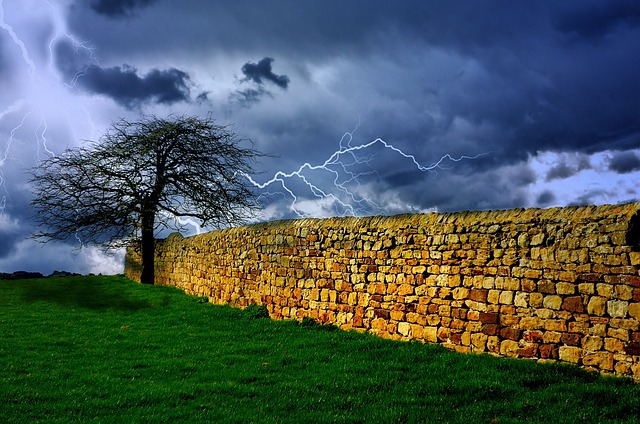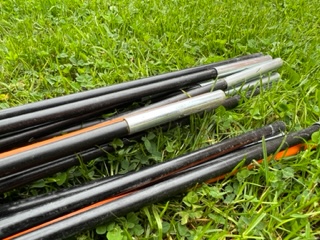This post contains affiliate links.
I love camping, but my fear kicks in when I think of lightning and thunderstorms. The fear of camping and being struck by lightning scares the hell out of me. You feel more exposed, surrounded by material and not solid brick walls.
Knowing how to easily protect yourself and your family while camping is important.
Remaining inside a tent during a thunderstorm is not advisable. Lightning will strike the highest point. Avoid camping near trees, high ground or open areas—shelter in a facility building or vehicle. Shut car windows, and avoid contact with handles, gear sticks or any other metal objects.
Thunderstorms are most common during Spring and Summer. Being prepared and aware of potential thunderstorms while camping is essential. Check the weather forecast before trips, be aware of dangers and how you can keep safe, including where to pitch, areas to avoid and prep to leave your tent if necessary.
1 – Stay or leave your tent during a thunderstorm?
It is not advisable, but many people stay in tents during thunderstorms. Remaining in your tent can be dangerous, so precautions are needed.
A tent will not directly attract lighting, depending on the surroundings. Lightning will aim for the highest point, normally trees and pylons. If you are pitched in the middle of open land or on the top of a hill, your tent is more at risk of being struck by lighting.
As campers, we will automatically try to pitch our tent using natural habitat for shelter from elements such as wind, rain and blazing sun. Few people will consider the dangers of pitching your tent under a tree or near wire fencing.
During our last camping trip, we were allocated a pitch in the middle of a field. I did not even think about the dangers of lightning. Unless we have a thunderstorm forecast, I do not worry. Although typical British weather can never be 100% reliable, it is always important to have options available to you just in case.
It is rare for a tent to be struck by lightning, but there is always a risk that it may happen. There is also a danger of injury due to nearby trees being struck by lightning, falling branches, side flash, ground current and conduction.
A tent is not as protective as a vehicle, which is a Faraday cage. If a tent is struck by lightning, energy will not discharge around the outside of the tent like a vehicle. The energy will travel directly to the ground, leaving the ground charged.
During a thunderstorm, precautions must be followed if you remain in your rent.
- Move objects away from the sides.
- Do not lean on the tent sides.
- Do not touch poles.
- Disconnect all electrical items and do not use
- Remain on rubber matting in the middle of the tent
Electrical items such as mobile phones and TVs need to be disconnected from electrical mains. Using a mobile is safe, but not whilst charging. Your camping EHU has an RCD that protects against electrocution, but it does not protect against electrical lightning surges.
Camping on a campsite, you are not always given a choice of pitches. If you are unhappy with the pitch, ask to be moved, especially if the weather forecast states thunderstorms.
2 – What to do if you are camping with no shelter

Being in the open, high ground or not finding shelter is dangerous during lightning storms. You must keep the least amount of contact with the ground possible and not lie down, as this exposes you to a higher risk of injury or death.
Crouch down, keeping your feet together, no other part of your body touching the ground. Place your head towards your knees, hands together. Remain in this position until the storm has passed, or at least 30 minutes between the last lighting and the rumble of thunder.
Remember, lightning can still strike within a 6-mile radius.
3 – Are tents at a higher risk of attracting lightning: Tent poles, air tents and flag poles

Poled or air tents will not directly attract lightning. Carbon fibre poles will attract lightning but not as much as aluminium poles, but the location of a pitch is more important. Pitching a tent under or near a tree increases the risk of lightning jumping to your tent by side flash lighting.
Lighting attracts the highest object; a tent is smaller compared to the surrounding natural objects. Many people will place flag poles outside their tents, creating a higher risk of being struck than a tent. Increasing the risk of the energy being dispersed by ground current or flash lightning.
Reduce the risk by dismantling flag poles or other high objects near your tent.
4 – Understanding the basics of lightning can save your life

Information gathered from the National Weather Service states there are 6 different lightning strikes. We are all aware of the direct hit lightning strike; it is important to consider the additional types of lightning whilst camping.
These will affect your safety and decide whether to remain in your tent or find shelter.
Side flash lightning
Lightning can change from its original path and travel from one object to another. This is known as a side flash. The lightning will strike a taller object, such as a tree and jump to a short object as energy travels downwards to the ground. A small object, such as a tent, is a short circuit to disperse energy and is normally within 2 feet.
Ground current lightning
Ground current occurs when lightning strikes an object, such as a tree, and energy is dispersed through the ground to another object. The current will not travel in one direction; it will strike and disperse in all directions, travelling up to 60 feet from the original strike location.
Ground current is the most dangerous and is known to kill farm animals in fields due to the erratic energy spread and point of contact with the ground. Therefore, if you are caught in a thunderstorm, do not lay down, as this leaves you at a higher risk of injury or death due to full-body contact with the ground.
Streamer lightning
Streamer lighting is less common. A positive charge, known as an upward streamer from the ground, reaches out to the negative charge of a lightning strike. Lightning can reach the ground in quick succession of 50m steps.
Conduction
Metal does not attract lighting but can provide a path for energy to travel. Lightning will strike an object and travel the length of another object, such as wire fencing, telegraph wires, or electrical wires inside a home. Anybody touching a light or other electrical items is at risk of injury. That is why it is advised not to handle electrical items during a lightning storm.
It is advised to unplug any electrical items, remove an EHU, and place them in a vehicle for safety during a lightning storm.
5 – Camping in a thunderstorm: Is your car safer than your tent?
Seeking safety during a thunderstorm in your car is safer than remaining in a tent. Most people believe that a vehicle is safe during a lightning strike due to rubber tyres. But this is not the case.
Car tyres are insulators, but they will not withstand the current of a lightning strike. The electrical lightning current can light an incandescent bulb for 3 months.
If a vehicle is struck by lightning, lightning will take the path of least resistance. Therefore, it will travel down and around the vehicle’s metal bodywork to the ground. Vehicles are Faraday cages. Convertible cars offer no protection against a lightning strike.
Precautions to be taken whilst sheltering in a vehicle during a thunderstorm:
- Close all windows
- Keep away from any metal objects. (gear stick, handles, ignition, radios, seat adjuster bars)
- Do not leave the car
- Sit with your hands in your lap to avoid touching anything
6 – Why close vehicle windows during a lightning thunderstorm
Keeping windows slightly ajar during thunderstorms can be very tempting as you may feel hot in a stuffy vehicle.
Closing all windows and keeping them closed during lightning storms is important for safety. A vehicle is a faraday cage where the outer shell will carry the electrical current and protect the inside. However, it is still important not to touch any metal objects inside.
Opening a window breaks the Faraday shell, and the electrical current will travel through a gap in the window to the inside of the car. Lighting will take the least resistance path: you or your children.
6 – Removing the fear of thunderstorms from kids
Remove fears from children by keeping them entertained and making the whole experience fun. Watch the lighting from a safe area and count together; this sometimes eases the fear of storms, especially if the seconds increase.
- Puzzle books
- Easy reading books
- Cards
- Keep blankets inside the car so kids can sleep and keep warm
- Keep snacks and drinks handy
7 – Signs you are going to be struck by lightning
It is not safe if your hair goes static during a thunderstorm and you are in the open. You need to go inside quickly. We have all rubbed a balloon onto our heads and moved away to watch our hair reach the balloon.
Keep this in mind if you are in the middle of a thunderstorm. If your hair goes static, the positive charges are reaching through you to the negative part of the storm.
Other signs are:
- Metallic taste
- Feel your arms are the hairs standing up
- Hear a buzzing, vibrating sound
- Tingling sensation
- Feeling dizzy
- Sweating
If you are camping, get inside a vehicle or the nearest building.
Related questions
Is counting between lighting and rumbles of thunder an old wives’ tale?
I always thought it was an old wives tale and something my mum would tell me to remove the fear of thunderstorms by counting between lightning and claps of thunder to see how far a storm is away from you.
It’s true; counting the seconds or using a stopwatch on your phone between lighting flashes and claps of thunder will help determine how many miles the storm is away from your location. Dividing by 5 will give the number of miles the storm is away from you, or divide by 3 for kilometres.
Ever heard of the 30-30 rule? A basic safety rule if lighting and thunder are 30 seconds or less between each, it is time to move to a safe area or building. Waiting 30 minutes from the last flash of lightning or clap of thunder before leaving a safe area.
Why is there lightning but no thunder
According to the Met Office, it is impossible to have lightning without thunder. Depending on location and visibility, lighting can be seen from 150 to 200 miles away. Thunder will not be heard if it is over 10 miles away.
Lighting can strike up to 10 miles from the centre of the storm. It is recommended to seek shelter if the distance is 6 miles or less. Thunder is soundwaves created by lightning as it heats the surrounding area and cools rapidly.
What to do if you are wild camping or hiking during a thunderstorm
Hiking and wild camping during thunderstorms is dangerous, especially on high or open ground. Before leaving home, check the weather forecast and be aware of potential thunderstorms.
Lighting can be seen from over 150 miles away and is more obvious at night. Seek lower ground immediately; if this is not possible, find shelter in a cave or a gully. Ideally, if you have time, dismantle your tent quickly and leave the area, especially if you are on higher ground.
If you cannot find shelter or get to the lower ground, place all metal objects away from you, especially hiking poles. Using a sleeping mat, crouch down, only your feet touching the ground with your head towards your knees.


